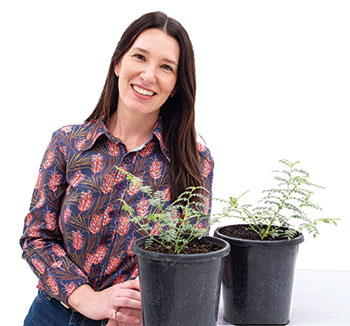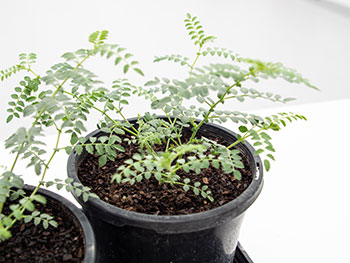Experts from around Australia are assimilating past learning and resources to mount an integrated push to deliver heat tolerance genetics to breeders
Chickpea stands as Australia’s most significant pulse crop but faces considerable challenges for future expansion. High temperatures in many growing regions hinder chickpea adaptation and there is a notable lack of genetic diversity for breeders to use to overcome this constraint.
To address these challenges, GRDC has invested in a new project spearheaded by the University of Queensland (UQ) that aims to accelerate the development of chickpea varieties that can withstand higher temperatures.
 Dr Millicent Smith at the new plant growth facility at the Saint Lucia campus of the University of Queensland. Photo: Megan Pope, University of Queensland
Dr Millicent Smith at the new plant growth facility at the Saint Lucia campus of the University of Queensland. Photo: Megan Pope, University of Queensland
Beginning in early 2024, this initiative seeks to consolidate available resources to enhance chickpea heat tolerance and establish a foundation for solving this issue. The project will leverage cutting-edge techniques such as crop modelling, high-throughput phenotyping, machine learning, and genomic predictions of breeding values.
This GRDC investment is led by Dr Millicent Smith, a crop physiologist at the UQ.
Dr Smith says the first year will entail combining and analysing historical data. Gaps in the knowledge base will then be addressed through targeted field and controlled environment experiments from 2025.
“We know that when it comes to heat tolerance, we are dealing with complex genetics due to an interacting suite of physiological traits,” she says. “That means many genes and gene interactions are at play.
“Deploying heat tolerance genetics will, therefore, entail learning which gene combinations to bundle together for different environments. Genomic prediction technology is ideally suited to performing these highly complex calculations and data integrations.”
For this project, Dr Smith has assembled a team that brings critical insight, experience and resources from the Australian chickpea industry, as well as world-leading expertise in key technologies.
This multidisciplinary approach reaches across all major chickpea production regions in Australia, including both high-temperature and heatwave environments. It also integrates leading experts in:
- crop physiology and modelling – UQ, Flinders University and the Queensland Department of Agriculture and Fisheries (DAF);
- high-throughput phenotyping – UQ and the University of Sydney (UoS);
- pulse crop agronomy – DAF, New South Wales Department of Primary Industries and Regional Development (NSW DPIRD) and Frontier Farming Systems;
- pulse crop genetics – UoS, UQ and Murdoch University;
- predictive breeding approaches – UQ; and
- speed breeding of pulse crops – Flinders University.
Project activities
 Dr Millicent Smith (right) and postdoctoral research fellow Shanice Van Haeften (left) with seed packets of diverse chickpea accessions at the NSW Department of Primary Industries and Regional Development Tamworth Agricultural Institute. Photo: University of Queensland
Dr Millicent Smith (right) and postdoctoral research fellow Shanice Van Haeften (left) with seed packets of diverse chickpea accessions at the NSW Department of Primary Industries and Regional Development Tamworth Agricultural Institute. Photo: University of Queensland
The mining of historical data will enable the team to compile a population of 400 chickpea lines that may harbour adaptation to high temperature. Included in this population are the 50 best-performing lines (with regards to high temperature tolerance) developed by Chickpea Breeding Australia (CBA). They are included on the premise that over the years, Australian breeders were indirectly selecting for heat tolerance. Also included are exotic landraces and wild relatives of chickpea.
The new analysis examines location (site, climate), yield, genomics and any available phenomics data for the past five years (from 2018). The goal is twofold:
- contribute to an understanding of what traits are available to protect chickpea crops from heat stress; and
- acquire a better understanding of what that heat stress looks like and how it varies across Australia.
The population will undergo field trials starting in 2025, with Flinders University’s expertise to be used to ensure the trials avoid the pitfalls and confounding effects that have affected screening for heat tolerance in the past. This includes optimal ways to use staggered sowing dates that help ensure test plots experience heat events.
These trials will provide a wealth of additional phenotyping information since the project plans to fly drones over the plots to acquire multispectral and hyperspectral data. Signals within this data can now be interpreted to reveal the biochemical basis underpinning yield development in heat and non-heat environments.
In all, Dr Smith envisions running 26 field trials over the life of the project.
Heat tolerance in relation to pollen sterility will additionally be examined in the newly opened Plant Futures Facility at UQ. The controlled environment rooms in this facility can simulate real-world heat stress events, down to the room’s humidity levels and elevated night-time temperatures. For example, they can be set to mimic the same conditions experienced at the Emerald research station.
“The use of the Plant Futures Facility opens up an exciting new chapter as it allows us to dissect more complex physiological traits more precisely,” Dr Smith says.
The final step involves processing all the yield, quality, genomics, phenomics, environmental and climate data using a genomic prediction framework. This requires generating a haplotype catalogue (a haplotype is a pattern of genetic diversity that is inherited together from a single parent).
AI algorithms will be applied to identify the optimal combinations of parents that maximise desirable haplotypes for heat tolerance. These parents will be used in genetic simulation studies to identify optimal crossing strategies that maximise gains in heat tolerance.
These crosses will be performed using accelerated breeding technology, with expertise at Flinders University capable of doing this even when wild relatives of chickpea are included.
 Chickpea plants at the University of Queensland’s new plant growth facility. Photo: University of Queensland
Chickpea plants at the University of Queensland’s new plant growth facility. Photo: University of Queensland
Dr Smith will be on standby to identify and quantify any yield penalties that may arise from including certain heat tolerance traits. She will also examine how these trade-offs may vary in different environments.
“The main output will take the form of a ‘base population’ that contains different configurations of desirable haplotypes for heat tolerance traits,” Dr Smith says. “This will provide a big step towards next-generation chickpea varieties with heat tolerance and enable a deeper understanding of the benefits and trade-offs associated with different trait combinations.”
In the first instance, field experiments for this project will focus on the heartland chickpea production zones (primarily in Queensland and NSW). However, with India removing tariffs from imported Australian chickpeas, the incentives exist to expand chickpea cropping.
As such, in the latter years of this project, Dr Smith will initiate the acquisition of phenotyping data from the chickpea expansion zones in Victoria (Mallee), South Australia (Eyre Peninsula) and WA.
More information: Millicent Smith, millicent.smith@uq.edu.au
GroundCover™ story – Genetics boost for pulses

























































